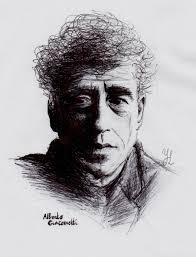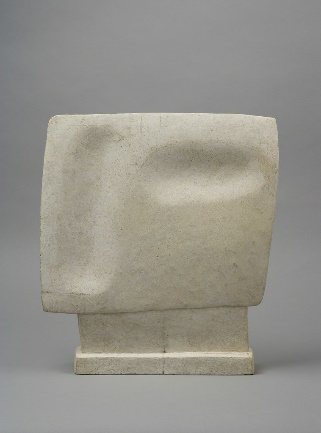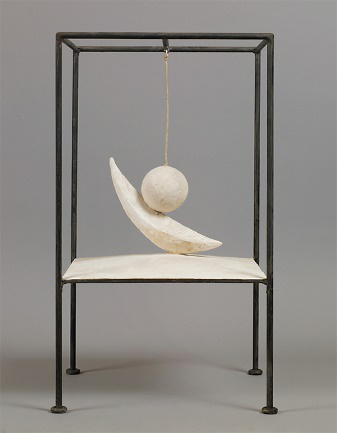
One of the most prominent painters and sculptors, Alberto Giacometti was born at the beginning of 20th century. At the period of the avant-garde, when the artists’ aim was to render some abstract and distinctive elements, not real ones, Alberto was working on achieving reality with the help of portraits. No matter whether they were drawn, painted or sculptured, the artist wanted a spectator to perceive the image as if all of the characters were alive people. Alberto Giacometti managed to do that by introducing into the art a new method on how to render a distance. The figures, he painted are seen from a specific angle, and that is why, the spectator perceives it as it is: within the distance, direction, and space.
Biography
Alberto Giacometti(1901-1966) was born in Eastern Switzerland in Borgonovo village. His father was a painter of Post-Impressionism and mother came from a family of big landowners. Almost all family members were outstanding artists, who worked in different techniques and belonged to different art movements. His biography may be divided into a few periods.
At the age of approximately ten years, Alberto was fond of drawing with pencil and crayon. His first sketches he sent to his godfather, who managed to save them up. The following years were full of experiments of oil and still life drawings. In a while, when he reached the age of twelve, the first artwork was brought into being.
In two years, the painter was admitted to Evangelical School of Schiers, where he was making art in a modest studio. After that, he attended the school of arts in Geneva, where he learned how to paint, draw and make sculpture under the custody of famous painter D. Estoppey and sculptor M. Sarkissoff.
Soon after, Alberto had a lot of opportunities to gain experience in the field of drawing and sculpture when traveling with his father to Italy and France. One of his first sculpture was put on an art exhibition in 1926 at the Salon de Tuileries. Later on, he advanced in sculpture, portrait and gesture drawings as well as painting.
The mature period of Alberto’s creativity was rich in new acquaintances, which later resulted in friendships and greatly influenced the work of the artist. Surrealism and other art movements absorbed him up to the hilt. In 1949 he got married to Annette Arm. His wife was a perfect model for almost all his drawings, among which is Annette with Chariot. In Paris, Alberto finally found his style, which is probably due to experience gained while painting on the streets.
One may notice that the late period is a devotion both drawing and sculpturing portraits. In the middle of 20th century, Alberto was widely known, but his health condition was getting worse. He worked hard until the last breath.11 January 1966 the outstanding artist passed away.
Key Ideas in painting
During the period of the 1930s, Giacometti’s creativity to a large extent contributed to the sculpture of Surrealism. He managed to come up with new ideas and objects in sculpture under the influence of Freud. In some of them, a primitivism may be seen, but the most impressive were ones that simulate game or toy, or any element of architecture. All of them kind of inspire the spectator to communicate with them, which had never been seen before in that field of art.
At the end of the 30s of 20th century, Alberto Giacometti refused to represent abstract and surrealistic things. Now, he took an interest in realistic ways to depict a person and nature. He was breaking his head over how to give the impression of a character as of a real person in real space. In his paintings, Giacometti attempted to convey the sense with the help of slender proportions.
Many existentialists and phenomenologists were impressed by Alberto’s achievement. What he found out concerning people’s representation in space superimposed on them. Both these movements consist of concepts concerning self-awareness and people’s relationship. It was believed, that Alberto’s art carried melancholic, subtraction and desolation moods suggested by these concepts.
Despite the fact that during the period of 1950-1960 abstraction was a center of art in both the USA and Europe, Alberto’s sculptures became a true example of how human being can become a piece of art. The figures he created, where the ones are standing alone, communicating with each other or with a spectator.
Famous paintings and sculptures made by Alberto Giacometti
The following pieces of artwork are the most famous figure drawings and sculptures.

In 1928 Alberto Giacometti produced work under name “Gazing Head.” At first, when the artist only began doing first steps in sculpture, it was hard for him to recreate from life. That is why he often tried to render what he had in his head. The main idea of the work lies behind the desire to evoke the thought that the thing they are gazing at is actually a mirror. Surrealists form France was deeply impressed by the sculpture when they first saw it in Paris during an art exhibition. It did lay a groundwork for the future career of the artist.

The next work is sculpture called “Suspended Ball.” Even though Gazing Head caught the eyes of Surrealism artists, it was Suspended Ball that pushed A. Breton to ask Alberto to come into line with them. The way the objects are combined suggests the qualities adored by Surrealists. Encouraged be this work, S. Dali wrote an article on the topic of surrealistic objects, which became a part of Breton’s magazine. However, there is another theory, which states, that it represents G. Bataille, who was Breton’s opponent.

One of the most famous oil paintings is “Annette with Chariot” created in 1950. Here, a viewer may notice how talented and skilled Alberto Giacometti was in painting. The painter managed to render the energy and strength with the help of oils and canvas. The technique used to depict the room is the same as one applied to the figure. Nevertheless, Alberto managed to emerge his wife from all the objects surrounding her by entrusting her with human qualities. Some of the scientists consider this painting as anti-poison for abstract ones.




